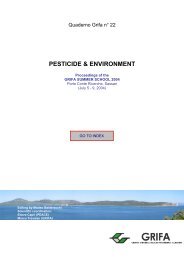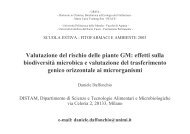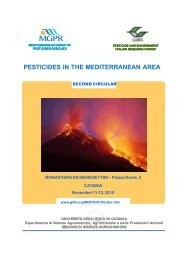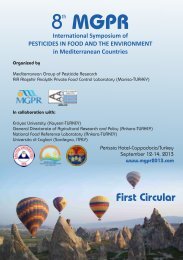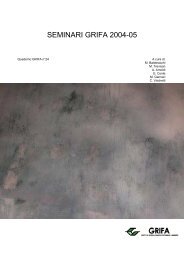International Congress BIOLOGICAL PRODUCTS - Gruppo di ...
International Congress BIOLOGICAL PRODUCTS - Gruppo di ...
International Congress BIOLOGICAL PRODUCTS - Gruppo di ...
Create successful ePaper yourself
Turn your PDF publications into a flip-book with our unique Google optimized e-Paper software.
ROTENONE<br />
Il principio attivo è estratto dalle ra<strong>di</strong>ci <strong>di</strong> Derris elliptica e <strong>di</strong> altre Papillionaceae appartenenti ai generi Lonchocarpus<br />
e Tephrosia; agisce per contatto e ingestione (La Torre et al., 2002). Ha bassa persistenza e si decompone rapidamente<br />
con l’esposizione all’aria e alla luce; non è selettivo nei confronti degli insetti utili né dei fitosei<strong>di</strong> (Tsolakis et al., 1997)<br />
ed è tossico per i vertebrati (Tremblay, 1985). In Italia il prodotto è stato registrato come liquido emulsionabile ad<br />
ampio spettro <strong>di</strong> azione, alla concentrazione del 6% <strong>di</strong> p.a. (“Rotena” Serbios, Tossico) e al la concentrazione del 4%<br />
(“Bioroten” Intrachem, Nocivo).<br />
Sono stati impiegati 3 formulati: Derisan (non registrato, 3-6 ml/l); Rotena (2,5 ml/l); Bioroten (3 ml/l) (tab. 2).<br />
Tab. 2 – Percentuali <strong>di</strong> mortalità (sec. Abbott) ottenute con Rotenone.<br />
Formulato Dose ml/l Insetto Sta<strong>di</strong>o Pianta % controllo<br />
Derisan 6 H . haemorrhoidalis Nean. - adulti viburno - labor. 50<br />
Rotena 2,5 – 2tr. viburno - campo 0<br />
Derisan 3 F. occidentalis Nean. - adulti pomodoro - serra 0<br />
fagiolino - labor. 13,4<br />
Bioroten 3 – 3tr. limonium - serra 49,3<br />
Derisan 6 E. phyllireae NinfeIV-V fillirea - labor. 0<br />
Rotena 2,5 L. alacris Ninfe I-II alloro - labor. 93,1<br />
Ninfe III-V " " 44,6<br />
Rotena 2,5 – 3tr. T. vaporariorum* Nean. I pomodoro -serra 55,7<br />
Nean. II-IV " " 60<br />
Rotena 2,5 P. citrella Larve I-II agrumi - vivaio 0<br />
Derisan 3 P. viburni Larve I viburno - labor. 7,9<br />
Bioroten 3 Larve I-II viburno - serra 100<br />
Rotena 2,5 Adulti viburno - labor. 93,3<br />
*Effetti negativi su E. formosa (sfarfallamento da 8, 75% a 32,5%)<br />
Rotenone è risultato me<strong>di</strong>amente efficace nei confronti <strong>di</strong> H. haemorrhoidalis con mortalità del 50% (Derisan) e<br />
verso le neani<strong>di</strong> <strong>di</strong> T. vaporariorum con 55,7 – 60% M (Rotena); assai efficace verso le giovani ninfe <strong>di</strong> L. alacris con<br />
mortalità del 93,1% (Rotena). Nei confronti <strong>di</strong> P. viburni, la resa del prodotto è stata assai <strong>di</strong>versa a seconda dello<br />
sta<strong>di</strong>o trattato e del formulato usato. Infatti mentre le larve <strong>di</strong> I età, sta<strong>di</strong>o più vulnerabile, sono sopravvissute in<br />
laboratorio al trattamento con Derisan, la mortalità <strong>di</strong> larve I-II trattate con Bioroten è stata del 100% e quella degli<br />
adulti trattati con Rotena è stata del 93,3%. Rotena ha avuto comunque effetti collaterali negativi molto pesanti su E.<br />
formosa, le cui percentuali <strong>di</strong> sfarfallamento sono state ridotte significativamente.<br />
AZADIRACTINA<br />
Dall’albero Aza<strong>di</strong>rachta in<strong>di</strong>ca (neem), della famiglia Meliaceae, originario dell’In<strong>di</strong>a, viene<br />
estratto un olio contenente numerosi principi attivi appartenenti alla classe dei limonoi<strong>di</strong> (aza<strong>di</strong>ractine), con proprietà<br />
antiparassitarie (Schmutterer, 1990; La Torre et al., 2002). L’estratto ha azione come regolatore <strong>di</strong> crescita,<br />
fagodeterrente e repellente e riduce la fecon<strong>di</strong>tà degli adulti e la vitalità delle uova (Rovesti e Deseo, 1990; Bezzi e<br />
Caden, 1991; Capella et al., 2000); agisce per ingestione e contatto e presenta un elevato potere <strong>di</strong> penetrazione (Isman<br />
et al., 1991). In Italia è commerciato come biostimolante vegetale (“Stardoor” Intrachem, EC 4,5%); inoltre sono stati<br />
registrati come insettici<strong>di</strong> due prodotti a base <strong>di</strong> aza<strong>di</strong>ractina A, che rappresenta la componente con le più elevate<br />
proprietà insetticide (“Oikos” Sipcam e “Diractin” Serbios, EC 3%, non classificati tossicologicamente).<br />
I formulati impiegati sono stati 4: Olnisan (non registrato, 2,5 ml/l); Stardoor (0,7 ml/l); Oikos (1-1,5 ml/l); Diractin<br />
(1,5 ml/l) (tab. 3).<br />
PDF creato con FinePrint pdfFactory versione <strong>di</strong>mostrativa http://www.secom.re.it/fineprint<br />
73



